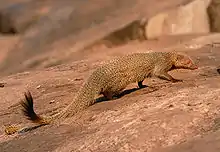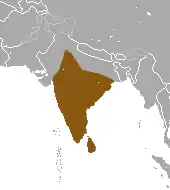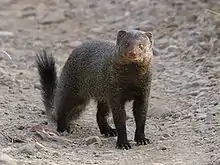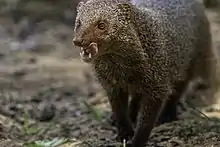Ruddy mongoose
The ruddy mongoose (Herpestes smithii) is a mongoose species native to hill forests in India and Sri Lanka.[1] This mongoose, along with the striped-neck and Indian grey mongeese, are the only mongoose species endemic to India and Sri Lanka. The ruddy mongoose is very closely related to Indian grey mongoose, but distinguished by its slightly larger size and black-tipped tail extending for 2 to 3 inches at the distal end. There are two subspecies of this mongoose, H. smithii smithii in India, and H. smithii zeylanicus (Thomas, 1852) in Sri Lanka.[2]
| Ruddy mongoose | |
|---|---|
 | |
| Scientific classification | |
| Kingdom: | Animalia |
| Phylum: | Chordata |
| Class: | Mammalia |
| Order: | Carnivora |
| Suborder: | Feliformia |
| Family: | Herpestidae |
| Genus: | Herpestes |
| Species: | H. smithii |
| Binomial name | |
| Herpestes smithii Gray, 1837 | |
 | |
| Ruddy mongoose range | |
Distribution and habitat


The ruddy mongoose is mainly a forest-living animal and prefers more secluded areas. It has also been recorded in secluded paddy fields and in comparatively open fields.[3]
Taxonomy
Herpestes smithii was the scientific name proposed by John Edward Gray in 1837 for a zoological specimen in the collection of the British Museum Natural History.[4]
Subspecies:
- H. s. smithii
- H. s. thysanurus
- H. s. zeylanius
Ecology
Like other mongooses, it hunts by day and by night.[3]
In culture
In Sri Lanka this animal is called mugatiya by the Sinhala speaking community and is usually regarded as an unlikable animal and a pest. The golden palm civet (Paradoxurus zeylonensis), altogether a different species endemic to Sri Lanka, is also called hotambuwa due to similar appearance and coloration.
References
- Mudappa, D. & Choudhury, A. (2016). "Herpestes smithii". IUCN Red List of Threatened Species. 2016: e.T41617A45208195.
- http://www.wii.gov.in/envis/envisdec99/ruddymongoose.htm
- Prater, S.H. (1971). The Book of Indian Animals (Third ed.). Bombay: Bombay Natural History Society. ISBN 019562169-7.
- Gray, J. E. (1837). "Description of some or little known Mammalia, principally in the British Museum Collection". The Magazine of Natural History and Journal of Zoology, Botany, Mineralogy, Geology and Meteorology. I (November): 577–587.

